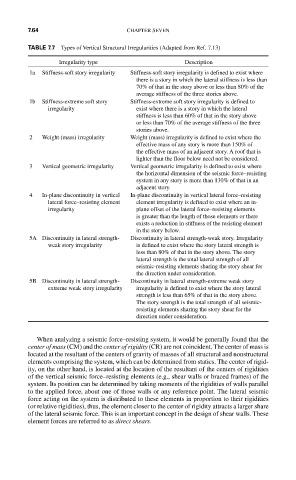Page 502 - Design of Reinforced Masonry Structures
P. 502
7.64 CHAPTER SEVEN
TABLE 7.7 Types of Vertical Structural Irregularities (Adapted from Ref. 7.13)
Irregularity type Description
1a Stiffness-soft story irregularity Stiffness-soft story irregularity is defined to exist where
there is a story in which the lateral stiffness is less than
70% of that in the story above or less than 80% of the
average stiffness of the three stories above.
1b Stiffness-extreme soft story Stiffness-extreme soft story irregularity is defined to
irregularity exist where there is a story in which the lateral
stiffness is less than 60% of that in the story above
or less than 70% of the average stiffness of the three
stories above.
2 Weight (mass) irregularity Weight (mass) irregularity is defined to exist where the
effective mass of any story is more than 150% of
the effective mass of an adjacent story. A roof that is
lighter than the floor below need not be considered.
3 Vertical geometric irregularity Vertical geometric irregularity is defined to exist where
the horizontal dimension of the seismic force–resisting
system in any story is more than 130% of that in an
adjacent story.
4 In-plane discontinuity in vertical In-plane discontinuity in vertical lateral force–resisting
lateral force–resisting element element irregularity is defined to exist where an in-
irregularity plane offset of the lateral force–resisting elements
is greater than the length of those elements or there
exists a reduction in stiffness of the resisting element
in the story below.
5A Discontinuity in lateral strength- Discontinuity in lateral strength-weak story. Irregularity
weak story irregularity is defined to exist where the story lateral strength is
less than 80% of that in the story above. The story
lateral strength is the total lateral strength of all
seismic-resisting elements sharing the story shear for
the direction under consideration.
5B Discontinuity in lateral strength- Discontinuity in lateral strength-extreme weak story
extreme weak story irregularity irregularity is defined to exist where the story lateral
strength is less than 65% of that in the story above.
The story strength is the total strength of all seismic-
resisting elements sharing the story shear for the
direction under consideration.
When analyzing a seismic force–resisting system, it would be generally found that the
center of mass (CM) and the center of rigidity (CR) are not coincident. The center of mass is
located at the resultant of the centers of gravity of masses of all structural and nonstructural
elements comprising the system, which can be determined from statics. The center of rigid-
ity, on the other hand, is located at the location of the resultant of the centers of rigidities
of the vertical seismic force–resisting elements (e.g., shear walls or braced frames) of the
system. Its position can be determined by taking moments of the rigidities of walls parallel
to the applied force, about one of those walls or any reference point. The lateral seismic
force acting on the system is distributed to these elements in proportion to their rigidities
(or relative rigidities), thus, the element closer to the center of rigidity attracts a larger share
of the lateral seismic force. This is an important concept in the design of shear walls. These
element forces are referred to as direct shears.

